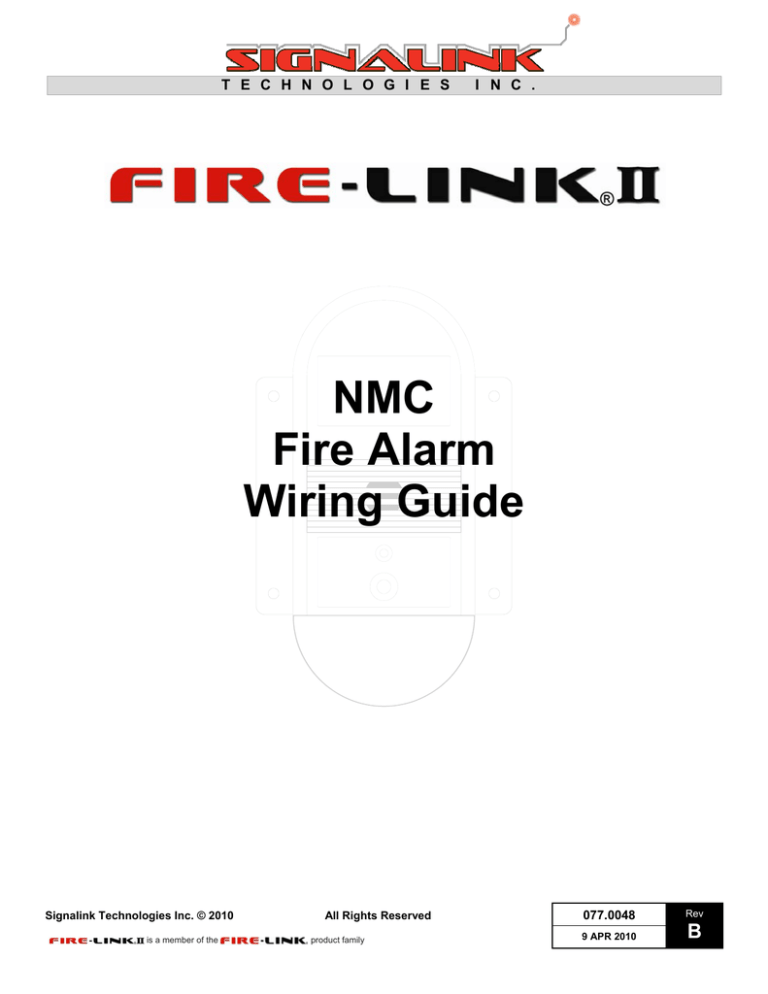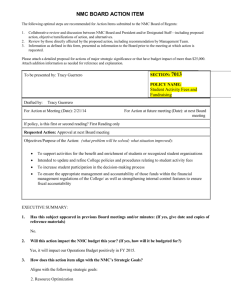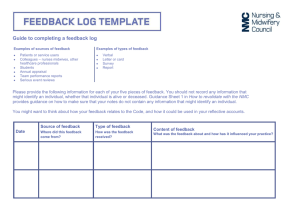
T E C H N O L O G I E S
I N C .
NMC
Fire Alarm
Wiring Guide
Signalink Technologies Inc. © 2010
is a member of the
All Rights Reserved
product family
077.0048
9 APR 2010
Rev
B
NMC Fire Alarm Wiring Guide
Table of Contents
1.0 General Product Information ............................................................................................................................................. 3
1.1 *** IMPORTANT *** Site Prequalification Requirement ............................................................................................... 3
1.2 Documentation Reference ............................................................................................................................................ 3
1.3 Applicable System Components ................................................................................................................................... 3
1.4 System Component Compatibility................................................................................................................................. 4
1.5 UL / ULC Listing Information......................................................................................................................................... 4
2.0 Pre-Wiring Check List ....................................................................................................................................................... 5
2.1 Location of Fire Alarm Equipment ................................................................................................................................ 5
3.0 NMC Configurations .......................................................................................................................................................... 5
3.1 NMC Configurations ..................................................................................................................................................... 5
3.2 Application .................................................................................................................................................................... 5
3.3 NMC Terminal Connections.......................................................................................................................................... 6
3.4 Accessory Mode (Using ISD Horns Only) .................................................................................................................... 6
3.5 Accessory Mode (Using ISD Horn / Strobes) ............................................................................................................... 9
3.6 Accessory with Strobe Mode (Using ISD Horn / Strobes) .......................................................................................... 10
3.7 Stand Alone Mode (Not Permitted in Canada) ........................................................................................................... 12
Signalink Technologies Inc. © 2010
All Rights Reserved
077.0048 REV B
Page 2 of 15
NMC Fire Alarm Wiring Guide
1.0 General Product Information
1.1 *** IMPORTANT *** Site Prequalification Requirement
The Fire-Link®II Site Prequalification form must be completed by the dealer or installer AND approved by Signalink
Technologies prior to installation of any Fire-Link® equipment. Equipment and/or installation warranties may be void
if this installation is not approved by Signalink Technologies.
1.2 Documentation Reference
The chart below lists the pertinent documentation to install Fire-Link®II equipment.
This is Document Number:
077.0048 - NMC Fire Alarm Wiring Guide
Fire-Link® II
Documentation Reference
Document Number
Document Name
Description
077.0024
NMC and TPC Installation Guide
Installation and 120V Wiring of the NMC, TPC and CHK-400
077.0050
TPC Installation Guide
TPC and CHK-400 Installation Instructions (Enclosed in TPC Unit Box)
077.0048
NMC Fire Alarm Wiring Guide
NMC Fire Alarm and Fire Alarm Control Panel (FACP) Interconnect Wiring
077.0049
ISD Installation, Operation and Maint. Guide
ISD Installation, Operations and Maintenance Guide
077.0045
NMC Programming Manual
NMC and ISD Programming and Set Up
077.0046
Signalink System Configurator User’s Manual
System Configurator User’s Guide for NMC Programming Via Laptop
077.0025
Building Manager’s Guide
NMC and ISD Operation, Test and Inspection Guide
1.3 Applicable System Components
This document applies to the following system components:
Signalink Technologies Inc. © 2010
All Rights Reserved
077.0048 REV B
Page 3 of 15
NMC Fire Alarm Wiring Guide
1.4 System Component Compatibility
The Fire-Link®II components are not compatible with previous Series 2.1 or Series 2.3 components. In addition, FireLink®II components are frequency dependent therefore one frequency series is not compatible with devices of a
different frequency series. See Compatibility Chart below.
z
kH
2
13 z
H
02
0k
-1
C
16
P
TP 01
-3
-1
C
C
SP 0
TP
0
-6
C
PP
z
H
2k
13
z
2
kH
50
0
-2
D
16
3
1
IS
2.
50
-2
ev
D
R
0
IS
.1
00 v 2
-1
e
D
R
0
IS
00
-1
D
IS
= Compatible
NMC-100 Rev 2.1
NMC-100 Rev 2.3
NMC-101 160kHz
NMC-102 132kHz
1.5 UL / ULC Listing Information
Fire-Link® II
UL / ULC Listing Reference
Model Number
UL / ULC Listing Standard
Description
UL-985
Residential Fire Warning Systems
NMC-101W, NMC-101R
UL-864 Accessory
Commercial Fire Alarm Applications (Accessory)
NMC-102W, NMC-102R
ULC-S527
Commercial Fire Alarm Applications (Accessory)
ULC-S545
Residential Fire Warning Systems
UL-508
Industrial Control Equipment
TPC-101, TPC-102, CHK-400
Signalink Technologies Inc. © 2010
All Rights Reserved
077.0048 REV B
Page 4 of 15
NMC Fire Alarm Wiring Guide
2.0 Pre-Wiring Check List
2.1 Location of Fire Alarm Equipment
It is important to how the NMC is to be configured and the location of the Building’s Fire Alarm Equipment since this
will determine the number of wires required, the size of wire and how the wiring is to be routed and installed. Different
configurations have different wiring requirements. In addition, it is important to know what the Fire Alarm Panel has
with regards to spare Bell and Input Zone circuits. Additional Fire Alarm equipment may be required depending on
the NMC configuration.
3.0 NMC Configurations
3.1 NMC Configurations
There are three basic NMC configurations each having their own wiring requirements. These wiring requirements are
largely based on what the building’s Fire Alarm Control Panel (FACP) is equipped with and if there is any
expandability within the FACP. The NMC must be capable of placing a trouble condition on the FACP as a code
requirement. Therefore for each NMC Configuration Mode, there may be several different wiring methods to support
trouble reporting.
3.2 Application
Accessory Mode and Accessory with Strobe Modes are approved for UL 864 and ULC S527 applications. NMCs
configured as Accessory or Accessory with Strobe Modes ARE NOT PERMITTED to be installed with any initiating
devices, such as smoke detectors, pull stations etc. connected to any of the NMC Detection Zone Inputs. NMCs
configured in Stand Alone Mode are approved for UL 985 applications and are allowed to have initiating device
inputs.
Signalink Technologies Inc. © 2010
All Rights Reserved
077.0048 REV B
Page 5 of 15
NMC Fire Alarm Wiring Guide
3.3 NMC Terminal Connections
Figure 1 shows the interconnect terminals on the NMC Main Board. Depending on the Configuration Mode, some of
the inputs are used differently in one mode versus the other. From left to right, they are:
The table below shows which inputs are used for the different modes. The NMC will ignore the inputs indicated for
the particular mode being used.
Mode
Bell Circuit I/O
Zone 1
Zone 2
Accessory
Used for Bell Input
Ignored
Ignored
Accessory + Strobe
Used for Bell Input
Used for Strobe Input
Ignored
Stand Alone
Ignored
Used for Normal Input
Used for Normal Input
DO NOT USE
NMC CONTROLLER – Main Board
BELL CIRCUIT INPUT AND
OUTPUT TERMINAL
J140
OUT+
OUT-
IN+
IN-
SIGNALAL OUTPUT RELAY
ALARM OUTPUT
RELAY
TROUBLE OUTPUT
RELAY
J109
NC1
COM
NO1
ALARM RELAY
NO2
COM
NC2
TROUBLE RELAY
INPUT DETECTION
ZONES 1 AND 2
1-
1+
2-
DETECTION ZONES
J110
2+
12VDC RESETTABLE
POWER OUTPUT
J141
+V
COM
RESETTABLE POWER
Figure 1: NMC Interconnect Terminals
NOTE: All unused NMC Detection Zones are to be terminated with a 3.9K, ¼ Watt End Of Line Resistor (EOLR). Use
the manufacturer’s recommended value of the of the End of Line Resistors for terminating FACP zones
3.4 Accessory Mode (Using ISD Horns Only)
When the NMC is configured in the Accessory Mode, the NMC receives its alarm input from the FACP bell circuit
output. When the FACP’s bell circuit goes active (into alarm), the NMC will go into alarm thus putting in ISDs into
alarm, sounding their buzzers. When the FACP’s bell circuit goes inactive (silenced or reset), the NMC will
automatically reset and reset the ISDs to Normal, buzzers off. In short, the NMC and ISDs act as if they are just
another bell on the FACP’s bell circuit loop. In the Accessory Mode and Accessory with Strobe Mode, there is no
need for user interaction with the NMC during or after a fire alarm condition. There are several possible wiring
methods for the Accessory Mode which depends on the FACP configuration. Each method describes what is
required of the FACP.
Signalink Technologies Inc. © 2010
All Rights Reserved
077.0048 REV B
Page 6 of 15
NMC Fire Alarm Wiring Guide
METHOD 1: (Preferred) Figure 2
FACP Requirement: One spare dedicated bell circuit
Wire Requirement: 1 pair FR-18
Supervision: NMC Trouble conditions will appear as an FACP bell circuit trouble
This is the simplest and most preferred method. A single pair of wires connected to the FACP bell circuit output is
connected to the NMC’s bell circuit input. A single wire is then connected from NMC’s Bell Circuit Output (-)
terminal to the NMC’s Trouble Relay Common contact. The EOL resistor is connected to the NMC’s Trouble
Relay NC contact and then a single wire is connected to the other side of the EOL resistor back NMC’s Bell
Circuit Output (+) terminal. This method provides complete system operation and supervision with a single wire
pair. With this method, the NMC will go into alarm when the FACP goes into alarm. If a Trouble condition exists
on the NMC, the trouble relay opens, opening the FACP bell circuit thus placing a trouble on the FACP.
NMC CONTROLLER – Main Board
FACP
BELL OUTPUT CIRCUIT
BELL CIRCUIT INPUT AND
OUTPUT TERMINAL
J140
OUT+
OUT-
IN+
ALARM OUTPUT
RELAY
TROUBLE OUTPUT
RELAY
J109
IN-
NC1
COM
NO1
NO2
COM
NC2
+
-
EOLR
Figure 2: Wiring Method 1
Signalink Technologies Inc. © 2010
All Rights Reserved
077.0048 REV B
Page 7 of 15
NMC Fire Alarm Wiring Guide
METHOD 2: (No spare, dedicated FACP bell circuit) Figure 3
FACP Requirement: One spare input zone circuit.
Wire Requirement: Two pair bell circuit wire, 1 pair FR-18
Supervision: NMC Trouble conditions will appear as an FACP input zone circuit trouble
If a spare dedicated FACP bell circuit is not available, then the FACP will require one spare zone input circuit for
NMC supervision. With this method, the NMC is connected in-line with the FACP alarm bells, just as if it was
another bell on the circuit. The FACP bell circuit loop will be required to be broken then two pairs of wires,
sufficient to carry the current of the entire bell circuit loop, will need to go to the NMC. One pair will be connected
FROM the bell circuit loop to the NMC’s Bell Circuit Input. The other pair will connect to the NMC’s Bell Circuit
Output and return TO the bell circuit loop. A third pair of wires (FR-18) is connected from the FACP’s spare input
zone to the NMC’s Trouble Relay for NMC supervision. One wire of the pair connects to the NMC’s Trouble Relay
Common contact. The EOL resistor is connected to the NMC’s Trouble Relay NC contact then the second wire of
the pair is connected to the other side of the EOL resistor then back to the FACP’s input zone. NOTE: It is
against codes and regulations to run the bell circuit loop through the NMC trouble relay since this will
open the bell circuit loop in the event of an NMC trouble.
NMC CONTROLLER – Main Board
IN-
NC1
COM
NO1
NO2
COM
NC2
-
IN+
INPUT ZONE
+
OUT-
FACP
TROUBLE OUTPUT
RELAY
BELL OUTPUT CIRCUIT
-
OUT+
ALARM OUTPUT
RELAY
J109
+
BELL CIRCUIT INPUT AND
J140 OUTPUT TERMINAL
EOLR
EOLR
Bell
Bell
Bell
Bell
Bell
Figure 3: Wiring Method 2
Signalink Technologies Inc. © 2010
All Rights Reserved
077.0048 REV B
Page 8 of 15
NMC Fire Alarm Wiring Guide
METHOD 3: (No spare, dedicated FACP bell circuit, No spare FAPC zone circuit) Figure 4
FACP Requirement: None
Wire Requirement: One pair FR-18
Supervision: NMC Trouble conditions will appear as an FACP bell circuit trouble
If no spare FACP bell or zone input circuit is available, the NMC may be connect as in METHOD 1 ONLY if it is
connected as the LAST bell in the bell circuit loop. The EOL resistor must be removed from the last bell on the
bell circuit loop and connected at the NMC as indicated in METHOD 1.
NMC CONTROLLER – Main Board
OUT-
IN+
IN-
NC1
COM
FACP
TROUBLE OUTPUT
RELAY
NO1
NO2
COM
BELL OUTPUT CIRCUIT
NC2
-
OUT+
ALARM OUTPUT
RELAY
J109
+
BELL CIRCUIT INPUT AND
J140 OUTPUT TERMINAL
EOLR
Bell
Bell
Bell
Bell
Figure 4: Wiring Method 3
3.5 Accessory Mode (Using ISD Horn / Strobes)
NOTE: This configuration mode is generally not acceptable. NFPA 72 and other fire alarm codes require that if the
FACP has been Signal Silenced, the strobes must continue to flash until the FACP has been reset. In this
configuration mode, the ISD Buzzers and Strobes follow the state of the FACP’s bell circuit. If the FACP has been
Signal Silenced, the FACP’s bell circuits are inactive, thus the ISD’s Buzzers and Strobes are inactive. To use ISD
Horn / Strobe units, the Accessory with Strobe Mode must be used.
Signalink Technologies Inc. © 2010
All Rights Reserved
077.0048 REV B
Page 9 of 15
NMC Fire Alarm Wiring Guide
3.6 Accessory with Strobe Mode (Using ISD Horn / Strobes)
When the NMC is configured in the Accessory with Strobe Mode, the NMC receives it alarm input from the FACP’s
bell circuit, as outlined in Section 2.3, to sound the ISD Buzzers. However, provisions must be made for controlling
the ISD Strobe. A relay contact must be available at the FACP and must be programmed or connected such that the
contact is closed as long as the FACP is in alarm, regardless of whether the FACP has been Signal Silenced. This
will keep the ISD Strobes active even though the ISD Buzzers are not. For the ISD Horn operation, follow the wiring
METHODS 1, 2 and 3 outlined in Section 2.3.
METHOD 4: (One spare FACP alarm relay) Figure 5
FACP Requirement: One spare alarm relay or programmable relay
Additional Wire Requirement: One pair FR-18
Supervision: Same as outlined in Section 2.3. The NMC supervises the FACP alarm or programmable relay
This is the simplest and most preferred wiring method for ISD Horn / Strobe units. The Normally Open relay
contact on the FACP is connected to the NMC’s Zone 1 input. The EOL resistor is connect at the FACP and the
circuit is supervised by the NMC. The FACP relay contact must be programmed or connect such that the contact
is closed during a fire alarm condition even if the bells have bee Signal Silenced. When the alarm condition is
cleared and the FACP is reset (Normal) the contact must open. The opening of this contact will turn off the ISD
Strobes.
NMC CONTROLLER – Main Board
BELL CIRCUIT INPUT AND
OUTPUT TERMINAL
J140
OUT+
OUT-
IN+
IN-
ALARM OUTPUT
RELAY
TROUBLE OUTPUT
RELAY
J109
NC1
COM
NO1
NO2
COM
NC2
INPUT DETECTION
ZONES 1 AND 2
1-
1+
2-
J110
2+
EOLR
EOLR
+
-
BELL OUTPUT CIRCUIT
FACP
COM
NO
PROGRAMMABLE
RELAY
Figure 5: Wiring Method 4
Signalink Technologies Inc. © 2010
All Rights Reserved
077.0048 REV B
Page 10 of 15
NMC Fire Alarm Wiring Guide
METHOD 5: (No spare FACP relay, one spare, dedicated output circuit, programmable) Figure 6
FACP Requirement: One dedicated FACP bell circuits, one dedicated output circuit, one supervised relay
Additional Wire Required: Subject to the requirements of the relay
Supervision: Same outlined in Section 2.3. The NMC supervises the relay. The FACP may also have a
supervision requirement of the relay
This method uses an external relay that is driven by the FACP output circuit. The FACP must be capable of
programming its output circuit to remain active while the FACP is in alarm, regardless if the other bell circuits have
been Signal Silenced. The relay output is connected to the NMC’s Zone 1 input. The EOL resistor is connect to
the relay and is supervised by the NMC. Additional requirements may be required by the FACP to supervise the
relay. DO NOT connect the any FACP bell or strobe circuit outputs directly to any of the NMC Zone Inputs.
Damage may occur to both the NMC and the FACP.
NMC CONTROLLER – Main Board
BELL CIRCUIT INPUT AND
OUTPUT TERMINAL
J140
OUT+
OUT-
IN+
IN-
ALARM OUTPUT
RELAY
TROUBLE OUTPUT
RELAY
J109
NC1
COM
NO1
NO2
COM
INPUT DETECTION
ZONES 1 AND 2
NC2
1-
1+
2-
J110
2+
EOLR
NO
EOLR
COM
BELL OUTPUT CIRCUIT
+
-
-
+
+
Supervised Relay
-
OUTPUT CIRCUIT
FACP
Figure 6: Wiring Method 5
Signalink Technologies Inc. © 2010
All Rights Reserved
077.0048 REV B
Page 11 of 15
NMC Fire Alarm Wiring Guide
3.7 Stand Alone Mode (Not Permitted in Canada)
When the NMC is configured as a Stand Alone unit, the NMC itself becomes the FACP. The NMC is capable of
controlling two Class B – Style B initiating circuits. The NMC input zones support any normally open initiating devices
such as pull stations, flow devices or 4 wire smoke or heat detectors. The recommended smoke detector is a System
Sensor model C4W-BA detector. For proper supervision, a System Sensor model A77-176B End Of Line Relay is
required to supervise the detectors power supply circuit. The NMC is capable of supporting any number of normally
open, switch type initiating devices but is ONLY capable of supporting TWO smoke detectors. Power for the smoke
detectors is provided at the NMC’s 12VDC Resettable Power terminals. When the NMC is RESET from a fire alarm
condition, the 12VDC Resettable Power circuit is de-energized for a period of 5 seconds to allow for smoke detector
reset. Refer to the User Reference Guide for NMC operation in the Stand Alone Mode. Figure 7 below shows the
method for connecting a 4-wire smoke detector and EOL Relay.
Note: The voltage range of the 12VDC Resettable Power is 10.7 to 20.3 VDC.
Note: Terminate all unused input zones with a 3.9K, ¼ watt resistor.
NMC CONTROLLER – Main Board
INPUT DETECTION
ZONES 1 AND 2
1-
1+
2-
J110
2+
12VDC RESETTABLE
POWER OUTPUT
J141
+V
C4W-BA
4-Wire Smoke
Detector
COM
(5) COM
(4) NO
(3) -IN/OUT
(2) +OUT
A77-716B
EOL Relay
COM
NC
ININ+
EOLR
(1) +IN
Figure 7: Four Wire Smoke Detector Wiring
Signalink Technologies Inc. © 2010
All Rights Reserved
077.0048 REV B
Page 12 of 15
NMC Fire Alarm Wiring Guide
User’s Notes:
Customer Feedback
We strive to make our documentation accurate and easy to understand. To help us improve our documents, your
feedback is very important to us.
If you have any comments or suggestions on how we can improve our technical literature, please email us at:
feedback@signalink.com
Please include this document number and revision found below. Thank you for your assistance.
Signalink Technologies Inc.
www.signalink.com
Technical Support: 1-888-765-7514
Signalink Technologies Inc. © 2010
All Rights Reserved
077.0048 REV B
Page 13 of 15
NMC Fire Alarm Wiring Guide
User’s Notes:
Signalink Technologies Inc. © 2010
All Rights Reserved
077.0048 REV B
Page 14 of 15
NMC Fire Alarm Wiring Guide
User’s Notes:
Signalink Technologies Inc. © 2010
All Rights Reserved
077.0048 REV B
Page 15 of 15



